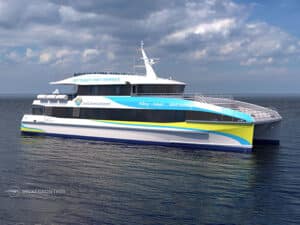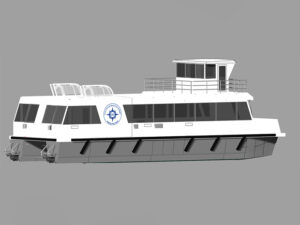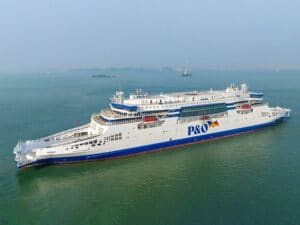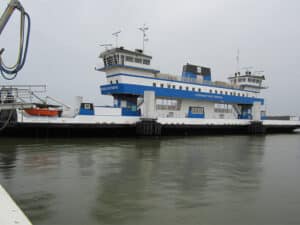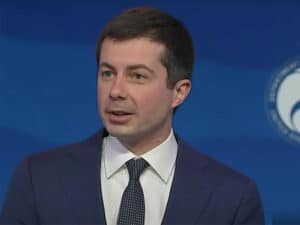
NYC DOT gets FTA grant to keep ferries running
Written by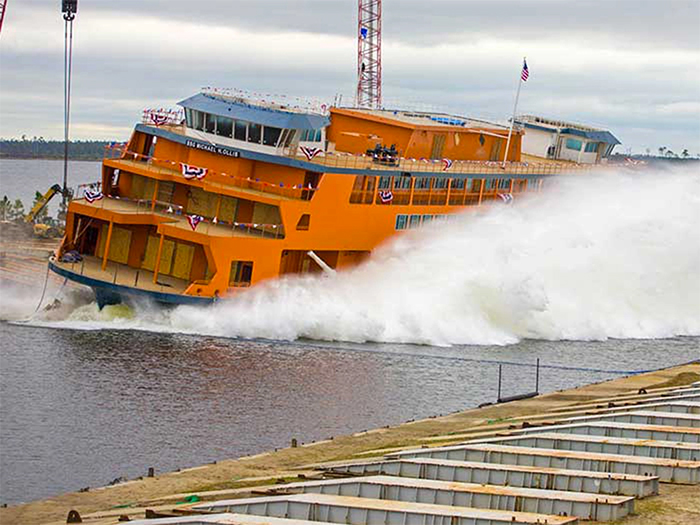
Eastern Shipbuilding launched the launched the SSG Michael H. Ollis, the first of three 320 ft Ollis Class ferries for the Staten Island Ferry Division of New York City’s Department of Transportation (NYCDOT), last November
by Larry Penner, FTA Region 2 (Ret.)

There is good news from Washington, D.C. concerning federal support for transportation. The New York City Department of Transportation is a direct recipient of Federal Transit Administration funding on behalf of the Staten Island Ferry.
On March 13, in response to the growing coronavirus pandemic, FTA announced the Emergency Relief Program. This affords transit operators such as NYC DOT permission to use previously apportioned funds, including federal fiscal year 2020 Urbanized Area formula funds, to pay for operating expenses related to COVID-19. This includes the flexibility of reprogramming existing grant funds to cover these unanticipated expenses.
NYC DOT recently received a $21.6 million grant from the FTA under the Corona Virus Aid, Relief and Economic Security (CARES) Act. These funds are intended for operating, preventative maintenance and administrative expenses to keep the Staten Island Ferry running. Why not also do the same for NYC Economic Development Corporation Private Ferry Operators program?
Federal support for the NYCDOT Staten Island Ferry, like all transit systems, has actually remained consistent and grown over time. When a crisis occurred, be it 9/11 in 2001 or Superstorm Sandy in 2012, Washington was there for us. Additional millions in federal assistance above and beyond yearly formula allocations were provided. In 2009, the American Recovery and Reinvestment Act (ARRA) provided billions more. A past $450 million federal TIFIA (Transportation Infrastructure Finance and Improvement Act) loan in 2000 paid for rehabilitation of the Staten Island Ferry’s St. George, Staten Island and Whitehall Street, Manhattan, terminals, along with three replacement ferryboats.
Most FTA grants require a 20% hard cash local share. CARES Act funding is 100% federal requiring, no local share.
FUNDING BACKLOG FOR FERRIES
It is disappointing that NYC DOT has a backlog of available FTA Passenger Ferry discretionary funding. The agency has been unsuccessful to date in accessing it. On Feb. 3, 2020, the FTA published a federal NOFA (Notice of Funding Availability) for federal Fiscal Year 2020. This included the availability of $16.28 million from 2014 and 2018 to pay for two new NYC DOT projects.
Details may be found under Table 14 – Prior Years Unobligated Section 5307 Passenger Ferry Grant Program. Among the funds available are $5.7 million from 2014 for Ferry Landing Modernization and Conversion to CNG (compressed natural gas) for fueling ferryboats, and $6.3 million from 2018 for facility/vessel gangways replacement/upgrade and ferryboat environmental compliance.
NYC DOT should have previously developed and submitted grant applications to apply for these funds. Why has NYCDOT been unsuccessful to date in having these funds obligated under approved grants? These funds will eventually lapse and be lost to NYCDOT. They end up returned to the federal treasury and may be reprogrammed for another purpose.
New ferry services can be implemented more quickly than construction of new subway, commuter rail or highways. These can take years or even decades until completion of environmental reviews, planning, design, engineering, real estate acquisition, permits, procurements and construction before reaching beneficial use. Completing all of the above, along with finding funding for ferryboats, docks, and parking with costs in the millions is easier than finding the billions of dollars for construction of new or extended subway, commuter rail or highways. Utilization of ferryboats equipped with fuel-efficient engines can make a positive contribution to air quality.
A LOOK BACK AT NYC AREA FERRY SERVICES
Prior to opening of the Verrazano-Narrows Bridge in 1964, there was ferry service from the Bay Ridge, Brooklyn 69th Street pier to the St. George, Staten Island Ferry Terminal with connections to the Whitehall Street, Manhattan Ferry Terminal
In April 1967, the Central Railroad of New Jersey ended ferry service between Liberty Street in New York City and Communipaw Terminal in Jersey City (today’s Liberty State Park, served by NJ Transit Hudson-Bergen Light Rail) when it closed the latter under the Aldene Plan. Later that year, in November 1967, the Erie-Lackawanna suspended ferry service between Barclay Street and Hoboken Terminal. Fast forward to today. Thousands of New Jersey daily commuters use ferries from Hoboken or Weehawken, N.J., to the downtown World Financial Center, Pier 79 West 38th Street or Pier 11 Wall Street Ferry Terminals. There are also 66,000 daily patrons of the Staten Island Ferry. Unlike the other four boroughs, 500,000 Richmond County residents have no direct subway or commuter rail system linking them with the rest of New York City. (Editor’s Note: MTA Staten Island Railway, operated by MTA New York City Transit, connects St. George with communities along Staten Island’s southern shoreline.)
NYC ECONOMIC DEVELOPMENT CORPORATION
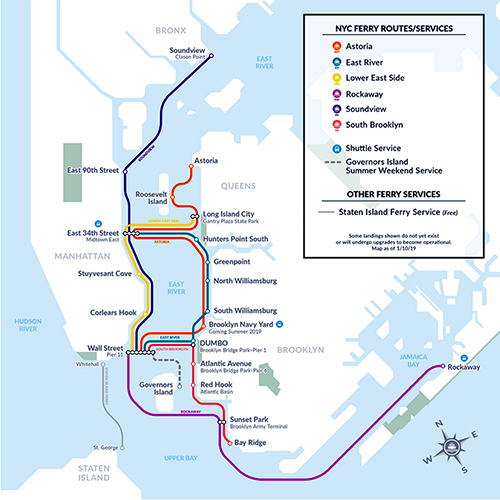
Thousands of riders on a daily basis utilize the NYC Ferry services sponsored by the NYC Economic Development Corporation Private Ferry Operators Program. They connect various waterfront neighborhoods including Soundview in the Bronx, Astoria, Long Island City, Roosevelt Island and the Rockaways in Queens, East 79th Street, East 34th Street, Pier 11 Wall Street and Governors Island in Manhattan, along with Greenpoint, Williamsburg, Brooklyn Bridge, Brooklyn Army Terminal and Bay Ridge in Brooklyn. New services are anticipated to start from Coney Island, Brooklyn, Throgs Neck/Ferry Point, Bronx and Staten Island South Shore in 2021.
NYC DOT can also apply for capital grants from the New York State Department of Transportation and other formula and competitive discretionary FTA grants to assist in funding. NYC DOT also provides State Transportation Operating Assistance. Ridership on any transit service generates yearly federal transportation capital assistance via the annual FTA Section 15 annual reporting process.
Numerous past private ferry operators have come and gone. They could not financially survive without government subsidy. New York MTA bus, subway and commuter rail, along with NYCDOT Staten Island Ferry is subsidized by a combination of city, state and federal assistance for capital and operating costs. All new ferry services will require similar subsidies if they are to survive.
The City of Glen Cove in suburban Nassau County is attempting to jump start its own ferry service to Midtown and Lower Manhattan. Perhaps it should consider working with the NYC Economic Development Corporation to add intermediate stops in Queens, including Bayside Fort Totten, College Point, Flushing Marina, LaGuardia Airport and Long Island City. This could generate significant additional riders, resulting in a more financially viable operation.
Ferry farebox recovery rates vary based upon the trip, route and time of day. Any rush hour local or express bus, subway, ferry, LIRR or Metro North trip carries more riders than midday, evening, overnight or weekends. Rush hour trips tend to have a better farebox recovery rate and require lower subsidies. There is always a fixed cost per hour for any mode of transportation. This includes equipment (bus, subway car, train or ferry purchase) straight line depreciation of equipment over time, and mileage, subway motorman, engineer or ferryboat captain’s salary, conductors, ticket takers, deck hands, fuel or power and maintenance of equipment.
NYC Mayor Bill de Blasio still needs to convince the MTA Board to support his fare structure of $2.75 per ride to also include cross-honoring a free transfer to a bus or subway using the current MTA Metrocard or future replacement OMNY Card for riders of the NYC Economic Development Corporation Private Ferry system. Riders could purchase weekly or monthly passes for discounted fares. These could be supplemented by using the Transit Check program, which will further reduce the cost per ride.
Who wouldn’t want to enjoy the fresh air and breeze that only waterborne transportation can provide? Riding a ferry can be less stressful than being packed in a subway car like sardines in a can.
NY MTA SHOULD LOOK TO L.A.
On another note, the New York Metropolitan Transportation Authority should consider following the open Los Angeles County MTA process for updating long-range capital plans. Whatever happened to the promised NYMTA 2020-2040 Twenty Year Capital Needs Plan? New York Governor Cuomo and the MTA pledged that it would be released by December 2019. It is now six months overdue. (Editor’s Note: Something called COVID-19 took over the world. Perhaps that has something to do with the delay?)
The plan documents how much money and years or decades will be required before each MTA operating agency, including NYCT bus, subway and Staten Island Railway, MTA Bus, Long Island Rail Road and Metro North Rail Road, have reached a state of good repair. Categories for each agency include such assets as the existing bus, subway and commuter rail fleet, stations including elevators to meet Americans with Disabilities Act requirements, escalators, track including switches, signals and interlockings, communications, line structures including painting, protective netting on elevated structures and bridges, line equipment including tunnel lighting and pump rooms, traction power including power substations, yards and shops and supervisory vehicles. It is suppose to be the basis for the justification of Five Year Capital Plans prior to their release. In this case, the $51 billion 2020-2024 Five Year Capital Plan was released and adopted prior to anyone seeing the updated Twenty Year Capital Needs Plan. The new 2020 – 2040 Twenty Year Plan should update the previous 2014 – 2034 Twenty Year Plan. Taxpayers, commuters, transit advocates and elected officials deserve to see this document today.
Did Cuomo forget his promise to conduct the most honest open transparent state government in history under his administration for all state agencies and authorities including the MTA?
This story was originally posted by our sister publication Railway Age

